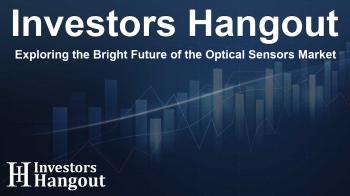Exploring the Bright Future of the Optical Sensors Market

Understanding the Growth of the Optical Sensors Market
In recent times, the Optical Sensors Market has gained significant traction, expected to reach an impressive USD 59.11 billion by a defined future period. This remarkable growth represents a CAGR of 11.1%, a reflection of both technological advancements and the expanding applications of optical sensors across various sectors.
The Versatility of Optical Sensors
Optical sensors have emerged as critical components in diverse applications, including manufacturing, consumer electronics, and healthcare. Presently, over half of all sensor applications in manufacturing utilize optical sensors for essential functions such as object detection and quality inspection. In the realm of consumer electronics, a staggering 60% of smartphones now incorporate these sensors, enabling features such as advanced camera functionality and automated screen brightness adjustments. Their integral role extends to advanced driver assistance systems in automotive technology and numerous biomedical applications, enhancing their market potential across various industries.
Innovation in Industrial Automation with Optical Sensors
The rise of Industry 4.0 and smart manufacturing has dramatically shifted how companies approach automation. The demand for enhanced operational efficiency has fueled the adoption of optical sensors, which are pivotal in ensuring accuracy in tasks such as quality control and position sensing. As manufacturers strive to automate processes to mitigate workforce shortages, the need for advanced sensing technologies has surged, driven further by the integration of the Internet of Things (IoT). This trend is particularly evident in automotive and healthcare sectors, where precise, real-time data processing is essential.
Market Segmentation and Key Players
The Optical Sensors Market is not only expansive but also diverse, with key players leading the charge. Prominent market players include ams-OSRAM AG, onsemi, TOSHIBA CORPORATION, and Honeywell International Inc. These companies are recognized for their pioneering products, encompassing optical sensors and machine vision systems that play crucial roles in enhanced automation and technological innovation.
Key Applications and Emerging Trends
Applications of optical sensors are swiftly evolving, particularly in biometric technologies and temperature sensing. Biometric applications, which have seen increased adoption in contactless payment systems, are projected to boost demand significantly as more individuals opt for secure transaction mechanisms. Meanwhile, advancements in materials science are propelling the growth of temperature sensing applications, with the segment expected to achieve a CAGR of 13.52%.
Geographic Market Insights
Asia Pacific currently dominates the optical sensors market, accounting for 39% of the total share, driven by surging sales in the automotive sector and burgeoning growth in consumer electronics. The region has seen a rise in the adoption of biometric authentication methods, further supporting market expansion. On the other hand, North America is anticipated to experience the most rapid growth, propelled by strong demand for electric vehicles and smart home technologies, along with a governmental push towards road safety.
Recent Developments Shaping the Market
Significant developments in the industry illustrate the ongoing innovation within the optical sensor space. For example, notable companies like SoftBank and TOSHIBA recently showcased advancements in Quantum Key Distribution combined with optical wireless communications. Additionally, ams Osram's strategic direction has seen them restructure by divesting from passive optical components to focus more keenly on intelligent sensor and emitter devices.
Frequently Asked Questions
What is driving the growth of the optical sensors market?
The optical sensors market is driven by advancements in technology, increased demand for automation, and the versatility of applications across various industries.
How significant is the consumer electronics sector for optical sensors?
The consumer electronics sector plays a massive role, with around 60% of smartphones utilizing optical sensors for functions like cameras and brightness adjustments.
Which regions are leading in optical sensor adoption?
Asia Pacific leads the market, while North America is projected to experience the fastest growth due to the adoption of electric vehicles and smart technologies.
Can you name some leading companies in the optical sensors market?
Some of the prominent companies include ams-OSRAM AG, onsemi, TOSHIBA CORPORATION, and Honeywell International Inc.
What are the emerging trends affecting optical sensors?
Key trends include the growing use of biometric technologies and advancements in temperature sensors, enhancing the demand and application of optical sensors.
About Investors Hangout
Investors Hangout is a leading online stock forum for financial discussion and learning, offering a wide range of free tools and resources. It draws in traders of all levels, who exchange market knowledge, investigate trading tactics, and keep an eye on industry developments in real time. Featuring financial articles, stock message boards, quotes, charts, company profiles, and live news updates. Through cooperative learning and a wealth of informational resources, it helps users from novices creating their first portfolios to experts honing their techniques. Join Investors Hangout today: https://investorshangout.com/
Disclaimer: The content of this article is solely for general informational purposes only; it does not represent legal, financial, or investment advice. Investors Hangout does not offer financial advice; the author is not a licensed financial advisor. Consult a qualified advisor before making any financial or investment decisions based on this article. The author's interpretation of publicly available data presented here; as a result, they should not be taken as advice to purchase, sell, or hold any securities mentioned or any other investments. If any of the material offered here is inaccurate, please contact us for corrections.
